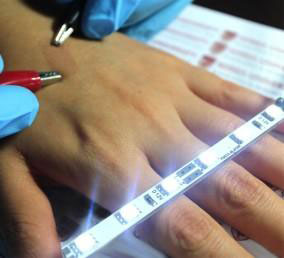| Posted: Jun 13, 2016 |
New nanomaterial offers promise in bendable, wearable electronic devices
(Nanowerk News) An ultrathin film that is both transparent and highly conductive to electric current has been produced by a cheap and simple method devised by an international team of nanomaterials researchers from the University of Illinois at Chicago and Korea University.
|
|
The film -- actually a mat of tangled nanofiber, electroplated to form a "self-junctioned copper nano-chicken wire" -- is also bendable and stretchable, offering potential applications in roll-up touchscreen displays, wearable electronics, flexible solar cells and electronic skin.
|
|
The finding is reported in the June 13 issue of Advanced Materials ("Self-Junctioned Copper Nanofiber Transparent Flexible Conducting Film via Electrospinning and Electroplating").
|
 |
| Highly conductive ultrathin film on skin between clips. (Image: Sam Yoon/Korea University)
|
|
"It's important, but difficult, to make materials that are both transparent and conductive," says Alexander Yarin, UIC Distinguished Professor of Mechanical Engineering, one of two corresponding authors on the publication.
|
|
The new film establishes a "world-record combination of high transparency and low electrical resistance," the latter at least 10-fold greater than the previous existing record, said Sam Yoon, who is also a corresponding author and a professor of mechanical engineering at Korea University.
|
|
The film also retains its properties after repeated cycles of severe stretching or bending, Yarin said -- an important property for touchscreens or wearables.
|
|
Manufacture begins by electrospinning a nanofiber mat of polyacrylonitrile, or PAN, whose fibers are about one-hundredth the diameter of a human hair. The fiber shoots out like a rapidly coiling noodle, which when deposited onto a surface intersects itself a million times, Yarin said.
|
|
"The nanofiber spins out in a spiral cone, but forms fractal loops in flight," Yarin said. "The loops have loops, so it gets very long and very thin."
|
|
The naked PAN polymer doesn't conduct, so it must first be spatter-coated with a metal to attract metal ions. The fiber is then electroplated with copper -- or silver, nickel or gold.
|
|
The electrospinning and electroplating are both relatively high-throughput, commercially viable processes that take only a few seconds each, according to the researchers.
|
|
"We can then take the metal-plated fibers and transfer to any surface -- the skin of the hand, a leaf, or glass," Yarin said. An additional application may be as a nano-textured surface that dramatically increases cooling efficiency.
|
|
Yoon said the "self-fusion" by electroplating at the fiber junctions "dramatically reduced the contact resistance." Yarin noted that the metal-plated junctions facilitated percolation of the electric current -- and also account for the nanomaterial's physical resiliency.
|
|
"But most of it is holes," he said, which makes it 92 percent transparent. "You don't see it."
|

